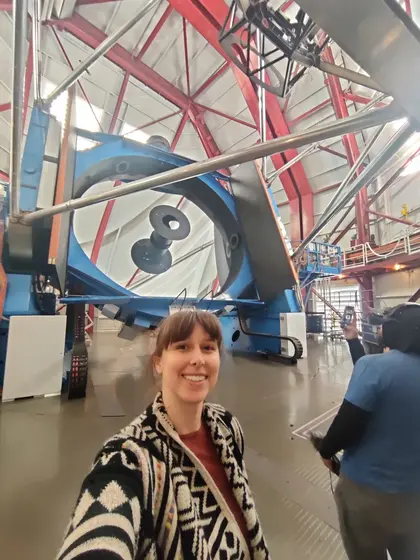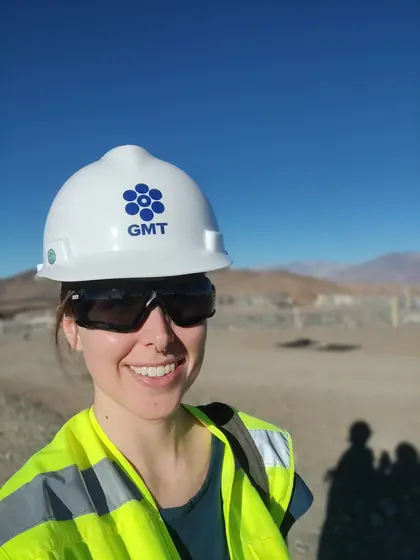What is your field of study and what's the coolest thing you’ve worked on so far in your career?

In simple terms, my research revolves around trying to understand where certain elements on the periodic table come from—namely the heaviest ones that are lower on the periodic table.
The last two rows of the periodic table represent the heaviest elements—uranium for example—and we can find some of these naturally on Earth. If we can find them on Earth, that means the universe had to have created them through some kind of stellar phenomena. So, we are looking to the stars for our answers.
My field is known as “galactic archaeology,” because we study really old “fossil stars” that help us understand the history of the galaxy, how it was made, and how it has evolved. But personally, I like to call it “stellar genealogy” because we are trying to trace the origin of the heavier elements by examining their lineage—how elements were inherited or passed down from one generation of stars to another.
The very last elements on the bottom right of the periodic table—with atomic numbers greater than 95—are the heaviest and, as far as we know, don’t exist in nature. They can only be created in a lab.
So, one really cool thing I worked on recently with some collaborators was making a prediction about whether or not we can say definitively whether nature can create those elements.
The reason we haven’t been able to make a determination before is because these particular elements are so radioactive and short-lived that they would have died away or decayed before we would have been able to observe them.
I enjoyed this particular project because it was a solid prediction on whether we can definitively say that these elements can be made in nature, or if they really are exclusively human made. Our findings were really more of a warning to the community to be careful when interpreting data, because our findings showed that the creation of these super heavy elements produces a signal that looks similar to something that doesn’t have those elements at all.
Another thing I study are stellar events called neutron star mergers. This is where you have two neutron stars orbiting each other. Eventually that orbit decays, and they collide into each other. When that happens, the explosion expels material or debris that can result in the creation of those super heavy elements.
Neutron stars themselves can be hard to study because they’re tiny, but we don’t know exactly how big they need to be to create these very heavy elements. I made a prediction where I applied both my observations and my models to ascertain, based on the existence of those elements, how big neutron stars need to be in order to reproduce what elements we see in stars.
In this work, I wasn’t actually observing neutron stars. Rather, I was trying to discern whether what I was seeing in the theory side of my research could reproduce real observations related to the creation of those very heavy elements. I wasn’t expecting that my study would match with more robust, direct studies of neutron stars, but my prediction actually agreed pretty well. So, it was rewarding that I created a totally independent metric for measuring neutron stars that agrees with other methods. I really liked this project. It really pulled together both the observational and theoretical sides of my work.
Did you always think you would be a scientist?
Both my parents, my uncles, both my grandfathers worked in the aerospace industry for corporations that essentially build satellites and launch them. And as a kid I always loved math and science and knew I wanted to go into science. I didn’t know what field exactly, but knew science was my path. I wasn’t actually attracted to astronomy from the beginning, despite so many family members being in the space field. It took me a while to find that. At first, I thought about doing geology and then I very seriously considered genetic engineering, and that was the last thing I wanted to do before I switched to astrophysics. It’s ironic that I was originally so interested in genetic engineering, because right now I am studying the genetics of stars, so it’s like I’m doing that but in another context.

Who is your "Science Superhero"?
There are so many that it’s hard to choose, but I’ll name a historical figure and a current figure. The historical figure is Margaret Burbidge, who worked for Carnegie as a telescope operator. She was brilliant and ended up writing a really groundbreaking paper in 1957 called “Synthesis of the Elements in Stars” about where elements come from and how we explain their origins. That’s a seminal paper in my field that everyone still references today.
Another one of my heroes, who is still alive, is Joycelyn Bell Burnell. She discovered pulsars and neutron stars when she was a grad student. Unfortunately, she didn’t get the credit. The Nobel Prize for that major discovery was awarded to her Ph.D. supervisor and two other men. But I really respect how she handled it. She never complained about it, she just showed a lot of grace. She had to deal with being one of the only women in a very male-dominated field and she didn’t get hung up on that. Thankfully, she did receive an award many years later that retroactively recognized her for her accomplishments.
Was your love of science shaped by a particular experience or mentor?
I had a few really good teachers in high school. In general, I felt really supported across the board, by my teachers and family. My mom always said that I could be whatever I wanted—even a garbage person—as long as I was happy.
Do you have a favorite galaxy?
I’m going have to say the Milky Way. Even though we only have a snapshot at this point in time, there’s a lot of data to draw from. Just by looking at the stars in the Milky Way, we can deduce its history, but there’s still so much more left to discover.
What are some of the challenges you have encountered in your career so far and how did you address them?
Imposter syndrome is something that has been a struggle. It’s that self-doubt, being afraid to ask an advisor for help because you don’t want to seem stupid. It’s really very isolating. Once I had the word for it and was able to identify what it was, it was a lot easier to deal with, and I recognized that I wasn’t alone. A lot of people feel insecure, especially when they’re starting out, and it’s important to talk about it because it might help others in the early stages of their careers.
Another challenge is navigating the historic, unrealistic expectations of astronomy, while at the same time establishing a healthy work-life balance. Astronomy, well really academia in general, can be toxic at times. There is this attitude that to be successful, you almost have to be perfect. You have to be able to write papers in two hours, for example, and be working until all hours. You can be an incredible astronomer and still have a life; the two aren’t mutually exclusive. But you have to be aware of that dynamic and really work at creating balance or you will burnout.
What advice would you give to graduate students and others who are just starting their scientific careers?
One piece of advice I’d give graduate students is to have hobbies outside of science. Early career scientists often think that to be successful they have to devote every waking hour to the lab or their research. I really encourage them to develop some kind of creative endeavor outside of work, something where they’re creating or making something. That way when they’re having a rough day with their research, which can be nebulous and frustrating at times, they can go home and make something tangible that they can be proud of. I think that really refreshes the brain. While I always wanted to do math and science as my career, all my hobbies are art oriented or creative. For example, I love to draw, sew, bake, and cook. Again, it really comes back to that work-life balance.
What do you think is the most exciting research direction happening in your field right now? And, looking 10 years ahead, what future development do you think will have the greatest impact on your field?
There’s something called gravitational waves. When neutron stars are orbiting each other and that orbit is decaying, the energy is being radiated through gravitational waves. And that’s something we can detect here on Earth. It takes tremendous effort, but I think it’s so cool that we can identify these tiny ripples in space-time.
I’d have to say advancements in the detection of gravitational waves. We have gravitational wave observatories on Earth, but hopefully, in 10 years we will have one in space that can detect those waves on longer time scales and at lower energies.

Why did you decide to do a postdoctoral position at Carnegie?
A lot of reasons. I knew of Carnegie’s reputation as a really engaging, collaborative environment. It was a place where I could see myself sharing ideas and not having to worry about competition. No one at Observatories is competing with anyone else there. We’re all really friendly, collaborative, and supportive. It’s just a really thriving research environment. Also, it has really amazing telescope access, so I knew I could do my research there because of its great resources. On a personal note, the Pasadena location was ideal because I grew up in the L.A. area, so I could be close to family at Carnegie.
What has your experience at Carnegie meant to you?
The two words I think of are support and fraternity. It really has been an honor and a pleasure working here. I think I will come away with not just some long-term collaborators, but some lifelong friends, as well. I gained a lot from Carnegie. It’s really nice knowing that I had so much support there. John Mulchaey, the Director of Observatories, is just amazing. It has been an absolute honor and a pleasure to work at Carnegie
